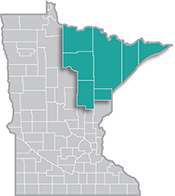 Home to the state's second-largest metro, the Northeast Region has a strong industrial sector, tied largely to the area's abundant natural resources.
Home to the state's second-largest metro, the Northeast Region has a strong industrial sector, tied largely to the area's abundant natural resources.
Most of the manufacturing base centers on mining and forest products industries. More than half of the sector's employment is in paper and machinery manufacturing.
Want the freshest data delivered by email? Subscribe to our regional newsletters.
6/22/2020 9:00:00 AM
Carson Gorecki
On March 27, 2020 the federal government passed the Coronavirus Aid, Relief, and Economic Security (CARES) Act, providing additional Unemployment Insurance (UI) benefits to eligible workers. A key piece of this emergency legislation is the Federal Pandemic Unemployment Compensation (FPUC), better known as the $600/week additional UI benefit. Any worker receiving regular or extended UI will also receive the $600 add-on.
For many of the lowest-paid workers, the FPUC is a critical source of much-needed income during a time when going to work increases the risk of contracting the coronavirus. The extra $600 helped more workers to stay at home, lowering their risk of infection and spread, which was desired during the early weeks of pandemic response, when many states, including Minnesota, instituted Stay at Home orders. However, now some question whether the FPUC is creating a disincentive for people to return to work as businesses reopen. Recent studies and articles show that a significant portion of unemployed workers make more from regular unemployment benefits plus the $600 add on than they did in the jobs that they were laid off from.
The replacement rate is the ratio of unemployment benefits to the lost wages of the worker receiving them. The National Bureau of Economic Research (NBER) found that the median replacement rate for U.S. workers with the $600 add-on was 134%, meaning most workers are receiving UI benefits greater than the pay from their previous jobs. In Minnesota, the median replacement rate with the $600 add-on included was 122%, based off the median wage for all occupations.
In Northeast Minnesota, the median wage is $18.57 an hour, or $743 a week for full-time workers. Assuming a UI benefit equal to half the worker's income ($371), the added $600 benefit would provide a weekly income of more than $970. In that case, a worker making the regional median wage would earn $227 more per week on unemployment than at work (see Table 1).
This unemployment addition is even more significant for lower wage workers. By comparison, the median food preparation & serving ($11.61/hr) or sales ($12.55/hr) worker would need hourly increases of approximately $9 and $8.75 respectively, to match the incomes of their unemployed colleagues.
| Occupational Group | Percent of Total Employment, 2019 | Percent of Unemployment Claims
(3/16-5/23/20) |
Median Weekly Wage (Full-Time), 2019 | Estimated Regular Weekly UI Benefit* | Estimated Total Weekly UI Benefit Including $600 Add-on | Estimated Unemployment Benefit Replacement Rate |
|---|---|---|---|---|---|---|
| Total, All Occupations | 100.0% | 100.0% | $743 | $371 | $971 | 131% |
| Food Preparation & Serving Related | 10.4% | 20.0% | $464 | $232 | $832 | 179% |
| Construction & Extraction | 4.3% | 10.5% | $1,095 | $547 | $1,147 | 105% |
| Sales & Related | 9.4% | 10.1% | $494 | $247 | $847 | 171% |
| Office & Administrative Support | 14.1% | 7.8% | $688 | $344 | $944 | 137% |
| Healthcare Practitioners & Technical | 8.0% | 7.3% | $1,238 | $619 | $1,219 | 98% |
| Healthcare Support | 4.5% | 5.7% | $614 | $307 | $907 | 148% |
| Building, Grounds Cleaning & Maint. | 3.7% | 4.5% | $540 | $270 | $870 | 161% |
| Personal Care & Service | 5.4% | 4.1% | $502 | $251 | $851 | 170% |
| Transportation & Material Moving | 5.0% | 3.7% | $722 | $361 | $961 | 133% |
| Arts, Design, Entertainment & Media | 0.9% | 2.1% | $801 | $400 | $1,000 | 125% |
| Community & Social Service | 3.6% | 1.2% | $800 | $400 | $1,000 | 125% |
| *Assuming 50% of median weekly wage. Source: DEED Unemployment Insurance Statistics, Occupational Employment Statistics | ||||||
Not all low-wage workers benefit from the FPUC. Those workers deemed essential continued to work, often in conditions placing them at higher risk of contracting the virus. Despite the increased risks, there is no similar program or policy to equitably compensate workers providing essential services; keeping our grocery stores and critical retail outlets running and safe or taking care of our loved ones. Some businesses have implemented hazard pay increases, but these increases are applied unevenly and often fall well short of the additional income that could be provided by the FPUC.
The income gap between low-wage workers receiving unemployment benefits and those continuing to work is stark. The exact effects of the FPUC will become clearer – for both employers and workers – as more businesses begin to reopen. Nevertheless, the $600 additional UI benefit has proven to be a much-needed lifeline for lower-wage workers, who are often most vulnerable to unforeseen financial fluctuations. However, if wages for the essential workers that remained in their positions on the front lines are to be equitable, hazard pay increases will need to commensurate.
Contact Northeast Minnesota Labor Market Analyst Carson Gorecki at 218-302-8413.